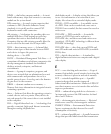
70 Glossary
ms — millisecond — A measure of time that equals
one thousandth of a second. Access times of storage
devices are often measured in ms.
N
network adapter — A chip that provides network
capabilities. A computer may include a network
adapter on its system board, or it may contain a PC
Card with an adapter on it. A network adapter is also
referred to as a NIC (network interface controller).
NIC — See network adapter.
notification area — The section of the Windows
taskbar that contains icons for providing quick access
to programs and computer functions, such as the
clock, volume control, and print status. Also referred
to as system tray.
ns — nanosecond — A measure of time that equals
one billionth of a second.
NVRAM — nonvolatile random access memory — A
type of memory that stores data when the computer is
turned off or loses its external power source. NVRAM
is used for maintaining computer configuration
information such as date, time, and other system
setup options that you can set.
O
optical drive — A drive that uses optical technology
to read or write data from CDs, DVDs, or
DVD+RWs. Example of optical drives include CD
drives, DVD drives, CD-RW drives, and CD-
RW/DVD combo drives.
P
parallel connector — An I/O port often used to
connect a parallel printer to your computer. Also
referred to as an LPT port.
partition — A physical storage area on a hard drive
that is assigned to one or more logical storage areas
known as logical drives. Each partition can contain
multiple logical drives.
PC Card — A removable I/O card adhering to the
PCMCIA standard. Modems and network adapters
are common types of PC Cards.
PCI — peripheral component interconnect — PCI is
a local bus that supports 32-and 64-bit data paths,
providing a high-speed data path between the
processor and devices such as video, drives, and
networks.
PCI Express — A modification to the PCI interface
that boosts the data transfer rate between the
processor and the devices attached to it. PCI Express
can transfer data at speeds from 250 MB/sec to 4
GB/sec. If the PCI Express chip set and the device are
capable of different speeds, they will operate at the
slower speed.
PCMCIA — Personal Computer Memory Card
International Association — The organization that
establishes standards for PC Cards.
PIO — programmed input/output — A method of
transferring data between two devices through the
processor as part of the data path.
pixel — A single point on a display screen. Pixels are
arranged in rows and columns to create an image. A
video resolution, such as 800 x 600, is expressed as the
number of pixels across by the number of pixels up
and down.
Plug-and-Play — The ability of the computer to
automatically configure devices. Plug and Play
provides automatic installation, configuration, and
compatibility with existing hardware if the BIOS,
operating system, and all devices are Plug and Play
compliant.
POST — power-on self-test — Diagnostics programs,
loaded automatically by the BIOS, that perform basic
tests on the major computer components, such as


















